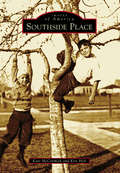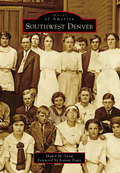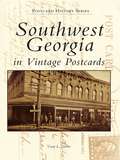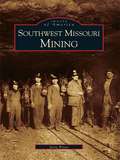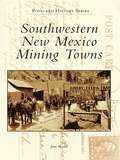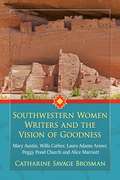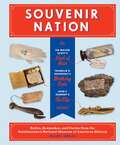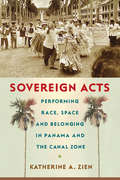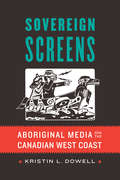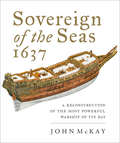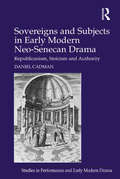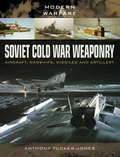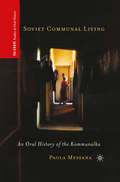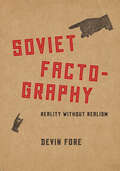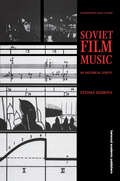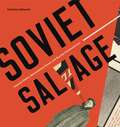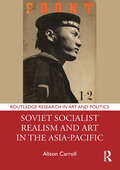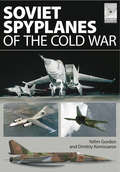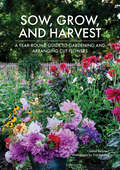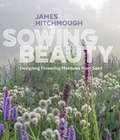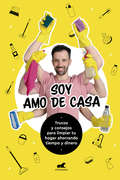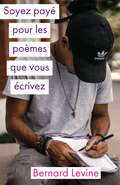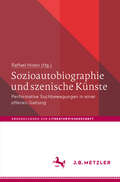- Table View
- List View
Southside Place (Images of America)
by Kris Holt Kate MccormickIn 1924, Edward Lilo Crain platted Southside Place, a 329-lot subdivision on the soggy prairie just west of bustling downtown Houston. Ahead of his time, Crain combined the roles of real estate investor, developer, and builder, establishing Southside Place with prefabricated catalog homes. The neighborhood's most defining attribute, however, is the 1.5-acre park Crain created as its geographic and civic center. This thoughtful early attempt at city planning made Southside Place the first Houston subdivision to provide a swimming pool, tennis court, clubhouse, and park for the private use of residents.
Southwest Denver (Images of America)
by Shawn M. Snow Jeanne FaatzIn 1900, the bucolic landscape that stretched for miles southwest of Denver was made up of truck farms, dairies, and ranches. While the separate town of Valverde would be absorbed by Denver in 1902, the countryside beyond was the domain of Arapahoe and Jefferson Counties. Isolated sentinels such as Loretto Heights and Fort Logan stood tall on the prairie. As happened in countless American cities, however, the abandonment of urban cores for new suburbs would radically change a rural way of life that had lasted for decades. With an aggressive annexation policy after World War II that helped to double Denver's land area in 30 years, the city set forth gobbling up these new subdivisions and former rural county lands. Some clamored to join Denver; others railed against the giant next door. A new sense of place was created in the process, not quite urban and not quite suburban. A proud heritage remains in the hearts of residents fortunate enough to have been brought into Southwest Denver before the annexation floodgates were permanently closed.
Southwest Georgia in Vintage Postcards
by Gary L. DosterFrom the 1890s through the 1920s, the postcard was an extraordinarily popular means of communication, and many of the postcards produced during this "golden age" can today be considered works of art. Postcard photographers travelled the length and breadth of the nation snapping photographs of busy street scenes, documenting local landmarks, and assembling crowds of local children only too happy to pose for a picture. These images, printed as postcards and sold in general stores across the country, survive as telling reminders of an important era in America's history. This fascinating new history of Southwest Georgia showcases more than two hundred of the best vintage postcards available.
Southwest Missouri Mining
by Jerry PryorThe southwest corner of Missouri made fortunes for many early settlers to the area, and created an economic boom rivaling the Gold Rush. In this new book, author Jerry Pryor creates a pictorial history of the efforts of those who staked everything on the chance of striking a fortune underground in the land west of the Mississippi. As early as the first Native American occupation of the region, mining for ore had always been an essential aspect of life in southwestern Missouri. In the mid-19th century, mining towns sprung up like weeds, with early wanderers hearing tales of fortunes made, sometimes accidentally, while plowing fields rich in ore. Joplin, Webb City, Carterville, and Oronogo all have origins in the mining camps that eventually grew into booming towns and cities. Soon this rich belt of mining land fostered a variety of lifestyles, ranging from the poor man's attempt to support his family under difficult and frightening conditions, to entrepreneurs such as Alfred H. Rogers, who organized the Southwest Missouri Electric Railway Company, the largest inter-city system west of the Mississippi.
Southwestern New Mexico Mining Towns
by Jane BardalSpanish and American prospectors discovered gold, silver, and copper mines in southwestern New Mexico in the 1800s. This volume explores the further development of these mining operations into the early 1900s. During this time period, improvements in technology made mining profitable, and eastern corporations invested in New Mexico mines. World War I created a demand for copper, and this era saw the development of paternalistic company towns. Miners faced difficult and dangerous working conditions, but their lives improved compared to previous generations. Many of the towns and the people in southwestern New Mexico owed their livelihood, in whole or in part, to mining. Some of these places have disappeared entirely, some are ghost towns, and others are thriving communities.
Southwestern Women Writers and the Vision of Goodness: Mary Austin, Willa Cather, Laura Adams Armer, Peggy Pond Church, Alice Marriott
by Catharine Savage BrosmanThis book, a project in literary history and criticism, examines five women authors of the American Southwest, two well known, three much less so: They stand out for their striving to give a woman's voice to aspects of the Southwest as it was during their lifetimes. All five authors displayed sensitivity to and concern for southwestern landscapes, arts, and people; they valued harmony in human relationships and endeavors; they were interested in the past and sought to preserve it. Marked differences in experience, temperaments, talents, and perspectives exist among them, however, although their common feminine condition supposes some similarity of approach, including limitations (biological and, to some degree, social).
Souvenir Nation
by William L. Bird Jr.Buried within the collection of the Smithsonian Institution's National Museum of American History exists an astonishing group of historical relics from the pre-Revolutionary War era to the present day, many of which have never been on display. Donated to the museum by generations of souvenir collectors, these ordinary objects of extraordinary circumstance all have amazing tales to tell about their roles in American history. Souvenir Nation presents fifty of the museum's most eccentric items. Objects include a chunk broken off Plymouth Rock; a lock of Andrew Jackson's hair; a dish towel used as the flag of truce to end the Civil War; the microphones used by FDR for his Fireside Chats; and the chairs that seated Nixon and Kennedy in their 1960 television debate.
Sovereign Acts: Performing Race, Space, and Belonging in Panama and the Canal Zone
by Katherine A. ZienSovereign Acts explores how artists, activists, and audiences performed and interpreted sovereignty struggles in the Panama Canal Zone, from the Canal Zone’s inception in 1903 to its dissolution in 1999. In popular entertainments and patriotic pageants, opera concerts and national theatre, white U.S. citizens, West Indian laborers, and Panamanian artists and activists used performance as a way to assert their right to the Canal Zone and challenge the Zone’s sovereignty, laying claim to the Zone’s physical space and imagined terrain. By demonstrating the place of performance in the U.S. Empire’s legal landscape, Katherine A. Zien transforms our understanding of U.S. imperialism and its aftermath in the Panama Canal Zone and the larger U.S.-Caribbean world.
Sovereign Screens: Aboriginal Media on the Canadian West Coast
by Kristin L. DowellWhile Indigenous media have gained increasing prominence around the world, the vibrant Aboriginal media world on the Canadian West Coast has received little scholarly attention. As the first ethnography of the Aboriginal media community in Vancouver, Sovereign Screens reveals the various social forces shaping Aboriginal media production including community media organizations and avant-garde art centers, as well as the national spaces of cultural policy and media institutions.Kristin L. Dowell uses the concept of visual sovereignty to examine the practices, forms, and meanings through which Aboriginal filmmakers tell their individual stories and those of their Aboriginal nations and the intertribal urban communities in which they work. She explores the ongoing debates within the community about what constitutes Aboriginal media, how this work intervenes in the national Canadian mediascape, and how filmmakers use technology in a wide range of genres—including experimental media—to recuperate cultural traditions and reimagine Aboriginal kinship and sociality. Analyzing the interactive relations between this social community and the media forms it produces, Sovereign Screens offers new insights into the on-screen and off-screen impacts of Aboriginal media.
Sovereign of the Seas, 1637: A Reconstruction of the Most Powerful Warship of Its Day
by John McKay“McKay’s artful renderings provide a fitting tribute to this amazing vessel and those who participated in her planning and construction.” —Pirates and PrivateersSovereign of the Seas was the most spectacular, extravagant and controversial warship of the early seventeenth century. The ultimate royal prestige project, whose armament was increased by the King’s decree to the unheard-of figure of 100 guns, the ship finally cost the equivalent of ten more conventional warships. A significant proportion of this total was spent on her gilded decoration, which gave the ship a unique combination of firepower and visual impact in battle that led her Dutch opponents to dub her the “Golden Devil.” It is unsurprising that such a high-profile ship should be well-documented, but there are no contemporary plans and much of the visual evidence is contradictory. In this book, John McKay sets out to analyze the data and reconstruct the design and appearance of the ship in a degree of detail never previously attempted. The results are presented as a folio of superbly drafted plans, isometric drawings and colored renderings, covering every aspect of the design from the hull form to the minutiae of sails and rigging. Each section is accompanied by an explanatory text, setting out the rationale for his conclusions, so the book will be of value to historians of the period as well as providing superb reference for any modeler tackling of one of the most popular of all sailing ship subjects.“A magnificent book on a magnificent ship.” —Nautical Research Journal“Very few books of warships contain the level of detail provided here.” —Firetrench
Sovereigns and Subjects in Early Modern Neo-Senecan Drama: Republicanism, Stoicism and Authority (Studies In Performance And Early Modern Drama Ser.)
by Daniel CadmanSovereigns and Subjects in Early Modern Neo-Senecan Drama examines the development of neo-Senecan drama, also known as ’closet drama’, during the years 1590-1613. It is the first book-length study since 1924 to consider these plays - the dramatic works of Mary Sidney, Samuel Daniel, Samuel Brandon, Fulke Greville, Sir William Alexander, and Elizabeth Cary, along with the Roman tragedies of Ben Jonson and Thomas Kyd - as a coherent group. Daniel Cadman suggests these works interrogate the relations between sovereigns and subjects during the early modern period by engaging with the humanist discourses of republicanism and stoicism. Cadman argues that the texts under study probe various aspects of this dynamic and illuminate the ways in which stoicism and republicanism provide essential frameworks for negotiating this relationship between the marginalized courtier and the absolute sovereign. He demonstrates how aristocrats and courtiers, such as Sidney, Greville, Alexander, and Cary, were able to use the neo-Senecan form to consider aspects of their limited political agency under an absolute monarch, while others, such as Brandon and Daniel, respond to similarly marginalized positions within both political and patronage networks. In analyzing how these plays illuminate various aspects of early modern political culture, this book addresses several gaps in the scholarship of early modern drama and explores new contexts in relation to more familiar writers, as well as extending the critical debate to include hitherto neglected authors.
Soviet Cold War Weaponry: Aircraft, Warships And Missiles (Modern Warfare)
by Anthony Tucker-Jones"In this companion volume to his photographic history of Soviet tanks and armoured vehicles, Anthony Tucker-Jones provides a visual guide to the vast array of aircraft, warships and missiles the Soviet armed forces deployed at the height of the Cold War. Although the superpowers never came to blows, the so-called 'Cold War' was far from cold, with numerous 'hot' proxy wars being fought in Africa and the Middle East. All these conflicts employed Soviet weaponry which has been captured in action in the colour and black-and-white photographs selected for this book. Between the 1950s and 1980s Soviet and Warsaw Pact countries churned out thousands of weapons ready for the Third World War. They also embarked on a technological arms race with NATO in an attempt to counter each new piece of equipment as it appeared. The MiG fighters, the Badger and Backfire bombers, the nuclear submarines have achieved almost iconic status, but, as Anthony Tucker-Jones's book shows, there was much more to the Soviet armoury than these famous weapons. Much of it, despite its age, remains in service with armies, guerrilla forces and terrorist organizations around the world today."
Soviet Communal Living
by Paola MessanaThis book brings together fascinating testimonies from thirty inhabitants of the 'Kommunalka,' the communal apartments that were the norm in housing in the cities of Russia during the whole history of the Soviet Union.
Soviet Factography: Reality without Realism
by Devin ForeA study of Soviet factography, an avant-garde movement that employed photography, film, journalism, and mass media technologies. This is the first major English-language study of factography, an avant-garde movement of 1920s modernism. Devin Fore charts this style through the work of its key figures, illuminating factography’s position in the material culture of the early Soviet period and situating it as a precursor to the genre of documentary that arose in the 1930s. Factographers employed photography and film practices in their campaign to inscribe facts and to chronicle modernization as it transformed human experience and society. Fore considers factography in light of the period’s explosion of new media technologies—including radio broadcasting, sound in film, and photo-media innovations—that allowed the press to transform culture on a massive scale. This theoretically driven study uses material from Moscow archives and little-known sources to highlight factography as distinct from documentary and Socialist Realism and to establish it as one of the major twentieth-century avant-garde forms. Fore covers works of photography, film, literature, and journalism together in his considerations of Soviet culture, the interwar avant-gardes, aesthetics, and the theory of documentary.
Soviet Film Music (Contemporary Music Studies)
by Tatiana EgorovaFirst Published in 1998. Routledge is an imprint of Taylor & Francis, an informa company.
Soviet Salvage: Imperial Debris, Revolutionary Reuse, and Russian Constructivism (Refiguring Modernism #23)
by Catherine WalworthIn Soviet Salvage, Catherine Walworth explores how artists on the margins of the Constructivist movement of the 1920s rejected “elitist” media and imagined a new world, knitting together avant-garde art, imperial castoffs, and everyday life.Applying anthropological models borrowed from Claude Lévi-Strauss, Walworth shows that his mythmaker typologies—the “engineer” and “bricoleur”—illustrate, respectively, the canonical Constructivists and artists on the movement’s margins who deployed a wide range of clever make-do tactics. Walworth explores the relationships of Nadezhda Lamanova, Esfir Shub, and others with Constructivists such as Aleksei Gan, Varvara Stepanova, and Aleksandr Rodchenko. Together, the work of these artists reflected the chaotic and often contradictory zeitgeist of the decade from 1918 to 1929, and redefined the concept of mass production. Reappropriated fragments of a former enemy era provided a wide range of play and possibility for these artists, and the resulting propaganda porcelain, film, fashion, and architecture tell a broader story of the unique political and economic pressures felt by their makers.An engaging multidisciplinary study of objects and their makers during the Soviet Union’s early years, this volume highlights a group of artists who hover like free radicals at the border of existing art-historical discussions of Constructivism and deepens our knowledge of Soviet art and material culture.
Soviet Salvage: Imperial Debris, Revolutionary Reuse, and Russian Constructivism (Refiguring Modernism)
by Catherine WalworthIn Soviet Salvage, Catherine Walworth explores how artists on the margins of the Constructivist movement of the 1920s rejected “elitist” media and imagined a new world, knitting together avant-garde art, imperial castoffs, and everyday life.Applying anthropological models borrowed from Claude Lévi-Strauss, Walworth shows that his mythmaker typologies—the “engineer” and “bricoleur”—illustrate, respectively, the canonical Constructivists and artists on the movement’s margins who deployed a wide range of clever make-do tactics. Walworth explores the relationships of Nadezhda Lamanova, Esfir Shub, and others with Constructivists such as Aleksei Gan, Varvara Stepanova, and Aleksandr Rodchenko. Together, the work of these artists reflected the chaotic and often contradictory zeitgeist of the decade from 1918 to 1929 and redefined the concept of mass production. Reappropriated fragments of a former enemy era provided a wide range of play and possibility for these artists, and the resulting propaganda porcelain, film, fashion, and architecture tell a broader story of the unique political and economic pressures felt by their makers.An engaging multidisciplinary study of objects and their makers during the Soviet Union’s early years, this volume highlights a group of artists who hover like free radicals at the border of existing art-historical discussions of Constructivism and deepens our knowledge of Soviet art and material culture.
Soviet Socialist Realism and Art in the Asia-Pacific (Routledge Research in Art and Politics)
by Alison CarrollThis study evaluates how the ideology of Socialist Realism, developed by the Soviets in policies and the practices of art, has been influential in the Asia-Pacific region from 1917 until today.Focusing primarily on Russia, then China, Vietnam, Korea, Singapore, Indonesia, the Philippines and Australia, this book demonstrates how each society adopted and adapted the Soviet example to make some of the most important imagery of recent history. Included is an examination of how the practice of Western art history, the nature of art history in Asia and the forces of the Cold War have led to this influence being inadequately acknowledged across Asia and more widely.The book will be relevant to those interested in art history, Asian studies, political history and cultural history.
Soviet Spyplanes of the Cold War (FlightCraft)
by Yefim Gordon Dmitriy Komissarov&“A good look at the MiG-25 recce birds...Definitely recommended!&”—Cybermodeler &“Spy in the Sky&” matters have long been a source of fascination for aircraft enthusiasts, historians, and modelers, and none more so than the elusive and secretive Soviet types of the Cold War era. Here, Yefim Gordon presents a range of such types, in a collection of photographs, profiles, and line drawings together with supplementary text detailing the history of each craft, encompassing the various developmental milestones, successes, and pitfalls experienced along the way. The Soviet Union&’s two dedicated spyplane types, the Yakovlev Yak-25RV &“Mandrake&” (the Soviet equivalent of the Lockheed U-2) and the MiG-25R &“Foxbat&” are profiled, supplemented by details garnered from a host of original sources. Well-illustrated histories and structural analyses are set alongside detailed descriptions of the various plastic scale model kits that have been released, along with commentary concerning their accuracy and available modifications and decals. With an unparalleled level of visual information—paint schemes, models, line drawings and photographs—it is simply the best reference for any model-maker setting out to build a variant of this iconic craft.
Sow, Grow, and Harvest: A Year-Round Guide to Gardening and Arranging Cut Flowers
by Chantal RemmertDirty hands, naturally grown plants, and a wild sea of flowers—all these characterize Sow, Grow, and Harvest: A Year-Round Guide to Gardening and Arranging Cut Flowers. Readers will learn to sow, grow, and harvest flowers, working year-round in their own gardens and home nurseries! As documented through the evocative lens of photographer Grit Hartung, Chantal Remmert presents a year in her nursery, laden with comprehensive step-by-step instructions. With practical DIYs and a program for every season—from sowing to cultivating, from harvesting and arranging ornate bouquets to overwintering plants—this book is a fundamental source for gardening beginners and seasoned flower enthusiasts alike. Key Features:Comprehensive DIYs covering all four seasons: Detailed projects for every season to nurture a garden and home nursery year-round, such as making willow tea, drying flowers, and creating indoor warming trays for plants.Practical tips: Easy-to-follow recommendations for sowing, cultivating, and harvesting, including guidance on select flower species such as tulips, dahlias, snapdragons, cosmos, and peonies.Sustainable techniques: Eco-friendly methods for selecting materials, gardening, composting, and creating beautiful, lasting bouquets.Evocative and practical photography: Gorgeous images that capture the essence of wild gardens and untamed flowers, while also providing a practical visual aid. An enchanting guide for those who find joy in the simple pleasures of cultivating and arranging flowers.
Sowing Beauty: Designing Flowering Meadows from Seed
by James Hitchmough“A hopeful and expansive book for the gardener who sees a field as a canvas.” —Publishers Weekly James Hitchmough is well-regarded in the design world for his exuberant, colorful, and flower-filled meadows. His signature style can be seen in prominent places like London’s Olympic Park and the Botanic Garden at the University of Oxford. Using a distinct technique of sowing meadows from seed, he creates plant communities that mimic the dramatic beauty of natural meadows and offer a succession of blooms over many months—a technique that can be adapted to work in both large-scale public gardens and smaller residential gardens. Sowing Beauty shows you how to recreate Hitchmough’s masterful, romantic style. You'll will learn how to design and sow seed mixes that include a range of plants, both native and exotic, and how to maintain the sown spaces over time. Color photographs show not only the gorgeous finished gardens, but also all the steps along the way.
Soy Amo de Casa: Trucos y consejos para limpiar tu hogar ahorrando tiempo y dinero
by Soy Amo de CasaAprendé a limpiar organizadamente con productos hechos por vos y convertí tu casa en tu lugar en el mundo. Tu casa debería ser un lugar al quieras volver siempre. Y para eso, además de ordenada, tiene que estar limpia. Soy Amo de Casa te muestra las mejores estrategias para lograrlo, a la vez que te enseña cómo hacer tus propios productos de limpieza con solo dos o tres ingredientes. ¿Sabías que el vinagre hace magia? ¿A qué tenés que dedicarle más atención y con qué frecuencia? ¿Qué podés hacer con esa mancha que no sale con nada? ¿Y con el sarro de la bañera? ¿Es posible recuperar una olla quemada o dejar impecable una pava? ¿Hay una forma eficaz de limpiar azulejos y pisos? ¿Cómo lograr que la ropa no quede arrugada? ¿Cómo quitarles el olor a las zapatillas? Soy Amo de Casa es tu aliado perfecto. El experto que te ayudará a transformar tu casa en tu lugar en el mundo.
Soyez payé pour les poèmes que vous écrivez
by Bernard LevineMaintenant, vous pouvez être payé pour la poésie que vous écrivez et faire publier vos poèmes dans des cartes de vœux, calendriers, affiches et plaques murales. Voici les renseignements exclusifs de Bernard Levine, auteur de cartes de vœux depuis plus de 30 ans, sur la façon dont vous aussi, vous pouvez être payé. Retrouvez tous vos vieux vers romantiques que vous avez écrits et faites publier vos poèmes avec de l'argent sur votre compte bancaire ! Écrire des poèmes pour de l'argent est une activité très amusante et très rentable ! Soyez payé pour faire ce que vous aimez.
Soziale Arbeit und institutionelle Räume: Explorative Zugänge (Sozialraumforschung und Sozialraumarbeit #18)
by Marc Diebäcker Christian ReutlingerAngebote Sozialer Arbeit werden selten auf Basis ihres institutionellen Kontextes reflektiert. Mittels einer räumlichen Perspektive eröffnen die Beiträge besondere Sichtweisen auf Bedarfe von Klient*innen, fachliches Arbeiten des Personals und vielschichtige soziale Beziehungen ‚vor Ort‘. Anhand explorativer Fallstudien aus unterschiedlichen Arbeitsfeldern Sozialer Arbeit werden soziale Ordnungen im Inneren der Einrichtungen rekonstruiert, die auf territoriale und gesellschaftliche Ausschließungsprozesse verweisen. Werden Einrichtungen der Sozialarbeit/Sozialpädagogik als institutionelle Räume gedacht, dann ergeben sich vielfältige neue Aspekte und Impulse, um professionelle Praxen reflexiv weiter zu entwickeln.Der InhaltTheoretische Zugänge zu institutionellen Räumen Sozialer Arbeit • Forschungsperspektive und -programmatik zur Analyse Sozialer Arbeit in institutionellen Räumen • Frauenhaus als Schutzraum • Tageszentrum für wohnungslose Menschen als Abweichungsraum • Wohngemeinschaft von Kindern und Jugendlichen mit Behinderung • Gebauter und gelebter Raum in der stationären Suchthilfe • Offene Jugendarbeit als raumbildende Praxis • Geschütze Werkstätten als institutionelle Räume • Kindes- und Erwachsenenschutzbehörde aus sozialräumlicher PerspektiveDie HerausgeberDr. Marc Diebäcker ist Professor an der Fachhochschule Campus Wien.Dr. Christian Reutlinger ist Professor an der FHS St. Gallen und leitet das Kompetenzzentrum Soziale Räume.
Sozioautobiographie und szenische Künste: Performative Suchbewegungen in einer offenen Gattung (Abhandlungen zur Literaturwissenschaft)
by Raffael HidenGesellschaftsdiagnosen durchkreuzen die Soziologiegeschichte in sehr unterschiedlichen Formen. Während sich geschichtsphilosophische Traditionslinien weitestgehend verflüchtigt haben, bestimmen aktuell interdisziplinäre und intermediale Experimentierfelder das Geschäft der Gesellschaftsdiagnose. Gegenwärtig wird diese Gattung mit performativen Instrumentarien erweitert, die im Zusammenhang stehen mit 'sozioautobiographischen' Schreibweisen . Gesellschaft wird hier zusehends mit dem Aufzug von Figuren und figurativen Darstellungsmodi an der Schnittstelle von Autobiographie und soziologischer Reflexion verhandelt. Dieser Band nimmt sich dieser Konjunktur an und versammelt Beiträge zur aktuellen Tendenz der szenischen Adaption bzw. Neuausrichtung dieser Stoffe, die anhand exemplarischer Fallbeispiele (u.a. Elfriede Jelinek, Milo Rau, Kim de l'Horizon) dargelegt werden.
